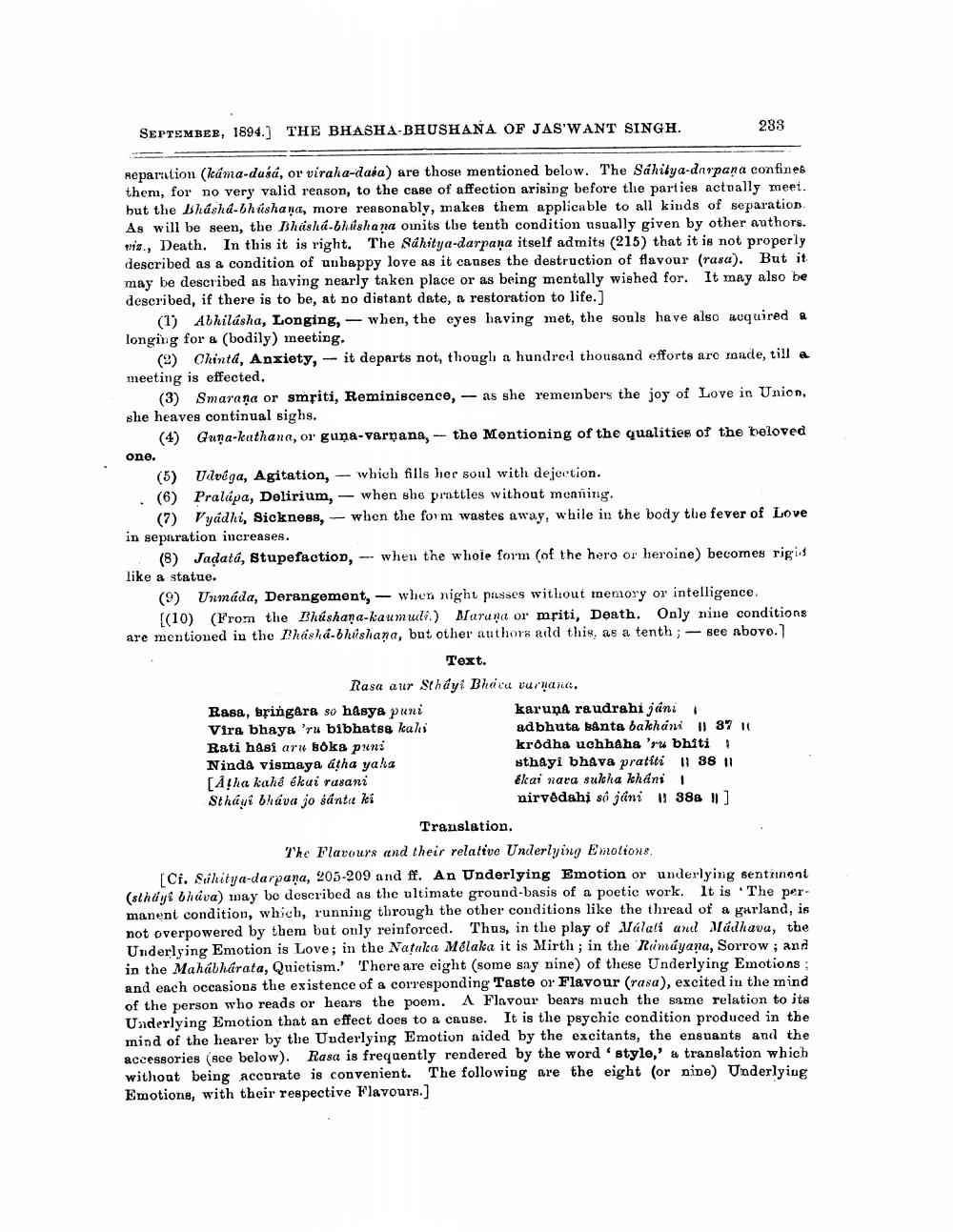________________
SEPTEMBER, 1894.] THE BHASHA-BHUSHANA OF JAS'WANT SINGH.
separation (kama-daśá, or viraha-daia) are those mentioned below. The Sahitya-darpana confines them, for no very valid reason, to the case of affection arising before the parties actually meet. but the Bhasha-bhúshana, more reasonably, makes them applicable to all kinds of separation. As will be seen, the Bhasha-bhushana omits the tenth condition usually given by other authors. vis, Death. In this it is right. The Sahitya-darpana itself admits (215) that it is not properly described as a condition of unhappy love as it causes the destruction of flavour (rasa). But it may be described as having nearly taken place or as being mentally wished for. It may also be described, if there is to be, at no distant date, a restoration to life.]
(1) Abhilasha, Longing,
when, the eyes having met, the souls have also acquired a
longing for a (bodily) meeting.
(2) Chintá, Anxiety, it departs not, though a hundred thousand efforts are made, till a meeting is effected.
(3) Smarana or smriti, Reminiscence,
as she remembers the joy of Love in Union,
she heaves continual sighs.
(4) Guna-kathana, or guna-varnana, the Mentioning of the qualities of the beloved
one.
(5) Udvéga, Agitation, (6) Pralapa, Delirium, (7) Vyadhi, Sickness,
which fills her soul with dejection.
when she prattles without meaning.
when the form wastes away, while in the body the fever of Love
when the whole form (of the hero or heroine) becomes rigid
(9) Unmáda, Derangement, when night passes without memory or intelligence. [(10) (From the Bhushana-kaumudi.) Marana or mriti, Death. Only nine conditions are mentioned in the Bhasha-bhushana, but other authors add this, as a tenth; see above.]
Text.
in separation increases.
(8) Jaḍatá, Stupefaction,
like a statue.
-
-
Rasa aur Sthayi Bhava varnana.
Rasa, sringara so hasya puni Vira bhaya 'ru bibhatsa kahi Rati hasi aru soka puni Ninda vismaya átha yaha [Atha kahé ékai rasani Sthayi bhava jo sánta ki
288
karuņa raudrahi júni
adbhuta santa bakhani 137 1
#
krodha uchhaha 'ru bhiti sthayi bhava pratiti 11 88 11 ékai nara sukha khani 1 nirvêdahi so júni
388]
Translation.
The Flavours and their relative Underlying Emotions.
[Cf. Sahitya-darpana, 205-209 and ff. An Underlying Emotion or underlying sentiment (sthay bhava) may be described as the ultimate ground-basis of a poetic work. It is The permanent condition, which, running through the other conditions like the thread of a garland, is not overpowered by them but only reinforced. Thus, in the play of Málati and Madhava, the Underlying Emotion is Love; in the Nataka Melaka it is Mirth; in the Ramayana, Sorrow; and in the Mahabharata, Quietism.' There are eight (some say nine) of these Underlying Emotions; and each occasions the existence of a corresponding Taste or Flavour (rasa), excited in the mind of the person who reads or hears the poem. A Flavour bears much the same relation to its Underlying Emotion that an effect does to a cause. It is the psychic condition produced in the mind of the hearer by the Underlying Emotion aided by the excitants, the ensuants and the accessories (see below). Rasa is frequently rendered by the word style,' a translation which without being accurate is convenient. The following are the eight (or nine) Underlying Emotions, with their respective Flavours.]




